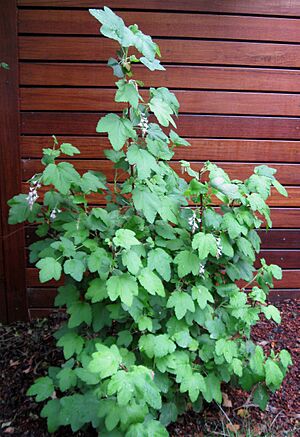Chaparral currant facts for kids
Quick facts for kids Chaparral currant |
|
|---|---|
 |
|
| Scientific classification | |
| Genus: |
Ribes
|
| Species: |
malvaceum
|
The chaparral currant, also known as Ribes malvaceum, is a cool plant from the gooseberry family. It grows naturally in California and northern Baja California. You can find it from sea level all the way up to about 4,900 feet (1,500 meters) high! This plant loves to grow in places like chaparral (shrublands), oak forests, and pine forests.
Contents
Meet the Chaparral Currant!
The chaparral currant is a type of shrub that comes back year after year. It usually grows to be about 5 to 10 feet (1.5 to 3 meters) tall. Unlike some other plants in the Ribes family, this shrub does not have sharp thorns on its stems.
Its leaves are about 0.8 to 2 inches (20–50 mm) long. They feel quite fuzzy and have tiny glands on them. The edges of the leaves are also double-toothed, which means they have small teeth along the main teeth.
Flowers and Berries
The chaparral currant has pretty flowers that grow in clusters of 10 to 25. These flowers bloom from October to April in their natural homes. Each flower has a pink base, called a hypanthium, which is about 0.2 to 0.3 inches (5–8 mm) long.
The sepals (which look like small leaves protecting the flower) are pink-purple. They are about 0.15 to 0.2 inches (4–6 mm) long. The petals are smaller, about 0.08 to 0.1 inches (2–3 mm), and can be pink or white. The flower also has two parts that help it make seeds, called styles, which are joined together and have a fuzzy base.
After the flowers, the plant grows amazing purple berries. These berries are about 0.2 to 0.3 inches (6–7 mm) wide. They are also covered in tiny glands and soft white hairs.
Different Kinds of Chaparral Currant
There are a few slightly different types, or varieties, of R. malvaceum:
- Ribes malvaceum var. clementinum — This variety was identified by Dunkle.
- Ribes malvaceum var. malvaceum — These plants usually have dark green leaves. You can find them growing below about 2,600 feet (800 meters).
- Ribes malvaceum var. viridifolium — This variety, identified by Abrams, has bright green leaves. It grows at higher elevations, up to about 4,900 feet (1,500 meters).
Growing Chaparral Currants
People often grow the chaparral currant in their gardens because it is a beautiful ornamental plant. Special nurseries sell them. It is a great choice for gardens that feature native plants. It also helps feed birds, making it perfect for a habitat garden. This plant grows really well under oak trees in sunny, dry spots, and in many other places too.
Scientists who study pollination say that the chaparral currant is important for attracting lots of native bees. It provides them with nectar, making it a valuable "honey plant."


